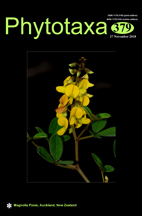Abstract
The present study reconstructs the phylogenetic relationships of the tribe with emphasis on Psychrogeton using both nuclear (ITS, ETS) and chloroplast (trnL intron and trnL-trnF intergenic spacer) markers. Divergence times for main lineages were estimated using BEAST analysis. Based on results of molecular analyses, tribe Astereae is circumscribed here as containing 16 genera and 38 species and comprising strongly supported five major clades: Aster, Chamaegeron, Erigeron, Galatella and Psychrogeton. Among the Eurasian asteroid taxa, Aster bachtiaricus formed the basal most diverging lineage far distantly from the Aster s.str. clade. Lachnophllum and Chamaegeron are sister taxa in nuclear tree, although weakly united in plastid topology. Galatella with the inclusion of Crinitina (= Crinitaria) constitutes a well-supported clade, which along with
Tripolium forms the Galatella group. Eurasian Erigeron species were derived within the Erigeron clade. Erigeron uniflorus subsp. daenensis and subsp. elborsensis are distinct from the type subspecies and are resurrected here as species in their own right. Our analyses of the datasets revealed that all examined species of Psychrogeton, except P. obovatus, emerged in a single clade comprising four distinct subclades. Molecular dating analyses indicate that tribe Astereae originated in the Late Eocene at 38.6 Ma. The most genera of Astereae diverged during the Middle Miocene whereas the diversification of lineages began mostly through the Pliocene and Pleistocene. On the basis of the molecular data as well as the morphological characteristics, Aster bachtiaricus was elevated to the generic rank and this new monospecific genus was named Iranoaster. Psychrogeton obovatus was treated as a member of the recently established genus Neobrachyactis. The conflicting position of some taxa including Lachnophyllum gossypinum, Dichrocephala, Myriactis and Asterothamnus in nuclear and plastid trees might be the result of ancient hybridization/introgression events.

